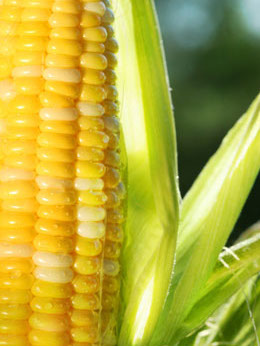Although corn cultivation may sound like a tedious job, it really is not, whether one is growing them in home gardens or commercially. Read this article to learn how to grow it.

The aroma of sweet corn being roasted or steamed, wafting through your kitchen on cold winter days is enough to warm your heart. Fresh food brings to the table unmatched flavor, taste, and aroma, fresh corn is no exception. Before we get down to the basic steps for growing it, let's learn a little about plant itself.
Corn Plant
A large crop plant, corn is a very popular vegetable. Its cultivation dates back to 8,000 years ago. Primarily, a native annual grass
teosinte, it has been domesticated into an edible fruit. The 20th century saw a jump in its production, as people were getting more interested in the health benefits it offered, as a whole vegetable, as well fresh or dried grain. A large number of
cultivars and hybrids were introduced in an attempt to yield more uniformed, better quality, and disease resistant crop. The type we see today is evolved from the
teosinte plants that had the largest amount of edible seeds. Unlike its originator, the
teosinte, which had very fragile seed compaction, the developed corn is tightly bound to the cob. The individual grain is known as a kernel, made up of hard and soft starch. As it is a
monocot, the grains are present in an even number of rows on the cob, which is tightly wrapped in leaves called the husk, and pistillate flowers known as silk. The husk is generally discarded before cooking.
How to Grow Corn
To grow corn at home, one can choose from several varieties, each with its unique taste and plant growing habits. Here, a generic form of information is given, with regards to growing them in small gardens.
Propagation: Seeds (dried kernels) are the only way to start a corn plant. One can purchase a particular variety or collect and store from last year's harvest. Collect seeds from a healthy ripened cob, and dry them well. Store them in a tight container in a dark cool place.
Soil Preparation: Corn grows properly in well drained fertile soil. Drainage is very essential to the growth, and for ensuring that the seeds do not rot. Ensure there are enough holes in the container, to allow adequate drainage. The soil's pH balance should be between 6.0 to 6.5. Sow the seeds (kernels) in early summer, directly in the intended location, in multiple rows, one inch deep, and 5-8 inches apart. The soil should be well fed with organic compost. Moisten the soil well, and keep it moist until you see sprouts in a week's time. It should be planted at close proximity in a group to facilitate pollination.
Watering: The corn plant requires plenty of water to produce full, healthy cobs/ears. As it is a summer crop and a fast grower, it needs plenty of water. Adequate water ensures that the kernels on the cobs become juicy and plumply. Inadequate water will wilt the leaves, and stunt the size of the cobs. These plants have shallow roots, so tend to dry out quickly. While watering, make sure water does not fall on the tassels, to produce the kernels on the cob, pollen from the tassels have to fall onto the silk.
Fertilizing: Corn likes plenty of nitrogen based fertilizer. A regular feed of liquid nitrogen based fertilizer should be applied regularly in its peak growing season. Test your soil's requirement before adding the nitrogen measure, excess will burn out your plant. Side dress between the rows.
Diseases and Pests: Corn is primarily inflicted by smut, leaf blight, and Stewart's disease. Anthracnose (a kind of leaf blight) can be controlled by treating the seeds before sowing, with a little dusting of Thiram or Captan. Pests that routinely attack this plant include corn borer, flea beetle, earworm, etc. Most of them just eat right through the cob. The use of specific germicides will prevent these diseases and pests from damaging the plant. While spraying any insecticide, make sure you avoid spraying the corn, if possible. Use cultivated varieties, as they are more resistant to being attacked.
Corn should be harvested at the right time to enjoy its taste. Squeeze the ear, if it feels plumply, pull a husk back, and pierce a kernel, if the juice is milky, it is ready to be harvested!






 The aroma of sweet corn being roasted or steamed, wafting through your kitchen on cold winter days is enough to warm your heart. Fresh food brings to the table unmatched flavor, taste, and aroma, fresh corn is no exception. Before we get down to the basic steps for growing it, let's learn a little about plant itself.
The aroma of sweet corn being roasted or steamed, wafting through your kitchen on cold winter days is enough to warm your heart. Fresh food brings to the table unmatched flavor, taste, and aroma, fresh corn is no exception. Before we get down to the basic steps for growing it, let's learn a little about plant itself.